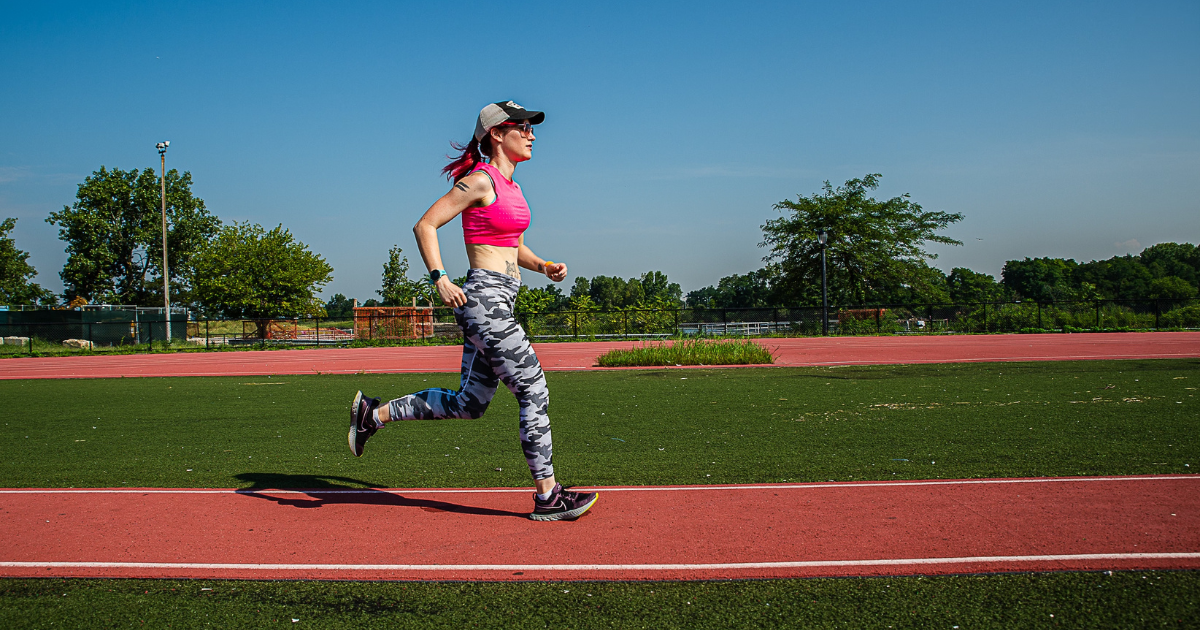Benchmark Run 101: How to Measure Your Running Progress
The track is a good place for benchmark runs. Photos by Marques Jackson Photography.
By Marnie Kunz,
Certified trainer and run coach
Whether you've just started running or are training for a big race, doing a benchmark run will help you measure your progress and stay on track. The benchmark run measures your base fitness level or starting point and then helps you see your progress over time as you continue your running program. Think of it as a pre-test and periodic quiz to assess how you’re doing as you work toward crushing your running goals. As a running coach, I often use benchmark runs to see where clients are with their running pace and measure the results of our speed workouts.
Related Post: Interval Training for Beginners with Sample Workout
One of the most common things I find with runners I coach is that they don’t have a concrete plan to accomplish their running goals. While getting clear on your running goals is the first step, the benchmark run is a great tool to help you bridge the gap between what you want to happen and making it happen in training. A benchmark run measures your running pace at regular intervals to see how fast you’re getting with your training. Whether you're following a marathon plan or training for your first 5K, benchmark runs will help you see your progress and see when your average pace gets faster.
I use benchmark running workouts for athletes I coach and some training programs, like Garmin Coach in Garmin Connect, also have you run benchmark workouts at the beginning of your training program. This allows the coach (or running app) to measure your current fitness level and running speed when you begin training. As you make progress and improve your fitness level through training, you’ll be able to see your running times improve with regular benchmark workouts.
Related Post: Garmin Running Workout Guide
What Is a Benchmark Run?
A benchmark run is a timed trial run at a set distance that measures your speed. Your first benchmark run will be at the beginning of a training program, and then you will have regular benchmark runs to assess your progress. Benchmark runs keep you accountable in your training and show you where you may need work as you progress in your running program.
To do a benchmark run, you will run at your maximum effort level, going all out for the duration of the run. Your benchmark run distance will always be the same but your pace should improve over time as you follow your training plan. Your run distance will always stay the same, making it easy to track your progress.
Benchmark workouts are not easy runs but are instead a form of speed training. If you want to do more speed workouts, try tempo runs and interval training to improve your running pace and benchmark times.
Benefits of Benchmark Runs
There are many benefits to doing benchmark runs. First, these assessment runs help measure your fitness level and progress as you follow your running plan. The benchmark run offers points on a map as you follow the route toward your running goals.
The benchmark also helps you turn your running goal into measurable milestones. Doing a benchmark run at the beginning of your training program measures your base level of fitness. As you put in the miles and work toward your running goal, benchmark runs will serve as regular check-ins to assess your progress. This keeps you accountable and on track, as you can identify your strengths and weaknesses as you look at your benchmark run results over time.
Benchmark runs help keep you grounded and focused in your training, giving you measurable results to assess if you’re on the right path to meet your running goals. If your benchmark results are not as fast as you’d like, you can then look at your training and tweak the program to get you back on track.
The benchmark run is also a form of speed workout and will give you the physical and mental benefits of running speed workouts — improving your running efficiency and leg strength, increasing your mental toughness, and burning a higher amount of calories than a regular or slow-paced run.
In summary, here are the benefits of doing benchmark runs:
Help measure your fitness level and progress in an objective, clear way.
Give you feedback on your training so you can adapt if you need to alter your workouts.
Offer benefits of speed training, including better running form, improved strength, and faster running speed.
Related Post: How to Run Faster - Tips from a Coach
Benchmark runs can range from 1 mile to 10K.
How to Do a Benchmark Run
To do a benchmark running workout, you need to first be clear on your running goals and have your training plan ready. Your benchmark distance will depend on your training plan. If you have your sights set on a mile race, your benchmark run will be shorter than someone who is training for the NYC Marathon, for instance.
Benchmark Run Warm-Up and Cooldown
Since the benchmark run is a speed workout, it’s especially important to warm up and cool down. Warm up with 10 minutes of slow running and dynamic stretches before your benchmark run. Cool down with 10 minutes of slow running followed by stretching.
Benchmark Run Distance
For runners with goals in the 1-mile to 5K race distance range, I recommend using the mile for your benchmark runs. If you are training for a 5-mile race or a 10K, your benchmark run should be 2 miles. For the half marathon runners, I recommend doing a 5K as your benchmark distance. If you are training for a marathon, run a 10K for your assessments.
Benchmark runs are a great training tool.
Here are some suggested benchmark distances for different race training programs:
1 Mile, 2 Mile, and 5K (3.1-mile) race training - 1-mile benchmark runs
5-Mile and 10K race training - 2-mile benchmark runs
Half marathon training - 5K benchmark runs
Marathon training - 10K benchmark workouts
There may be some variability with the best benchmark run distance for you, depending on your running level and training plan. If you are a beginner and already have a lot of speed workouts in your training plan, for example, you may want to do shorter benchmark runs with less frequency to avoid overtraining.
How Often to Do Benchmark Runs
Everyone should do a benchmark run at the beginning of a training plan. The first week of training is a good time to do your benchmark. After that, it depends on your training plan length but generally, I recommend doing benchmark runs every other week for shorter training plans (1- to 2-month training programs), and for longer training programs, do benchmark runs at least once a month.
Do your final benchmark run at least 1 week before your race for shorter distance races and at least 2 weeks before your race for longer races like the half marathon and marathon. You do not want to do your final benchmark workout too close to your race date as it will tire you out. Since you'll be tapering (reducing your running mileage) leading up to your race, you'll want to get your benchmark workout in before you start your taper.
To avoid overtraining, take an easy day or rest day after your benchmark workout since it is a speed training day, which is categorized as a hard workout.
Your Running Program
In order for your benchmark runs to pay off, you will need to have a running program based on your running goals. A good training plan will meet you where you are at with your current fitness level and give you a blueprint for meeting your running goals. Whether you want to run a faster mile or tackle your first half marathon, it’s important to have a running program to put your dreams into action.
A running plan should take into account certain training principles to build your fitness level and mileage gradually and strategically. If you need help with a plan, check out the Runstreet Training Center for customized training plans.
Have you tried benchmark workouts to track your training progress? Follow and tag @Runstreet on Instagram to share your training so we can cheer you on and see your progress! Happy running to you.😊
Related Posts: Best Glute Exercises to Get Results, 10 Running Workouts to Build Speed and Endurance
Marnie Kunz is a NASM-certified trainer and USATF- and RRCA-certified running coach, dog lover, Akita mom, and writer based in Brooklyn, NY. She is the founder of Runstreet and Book of Dog.





